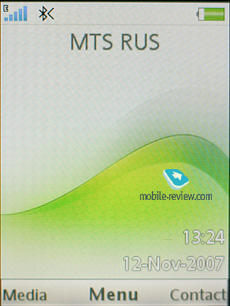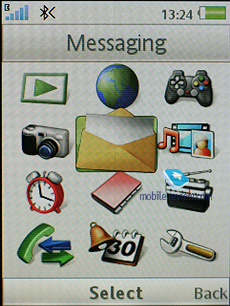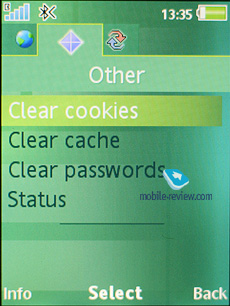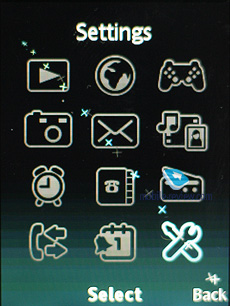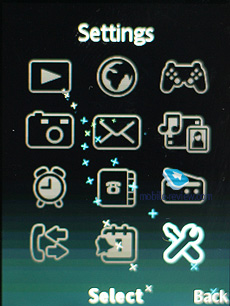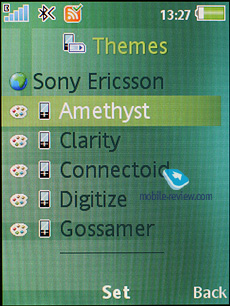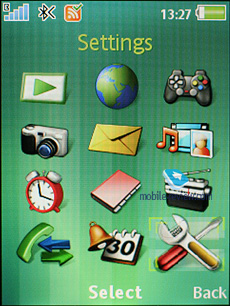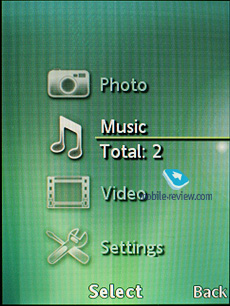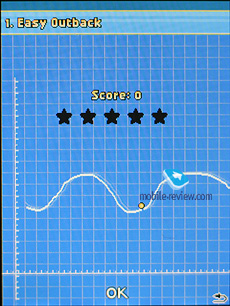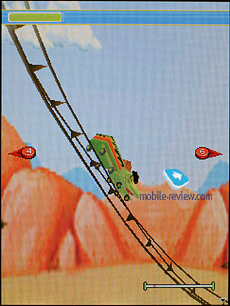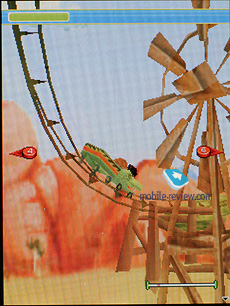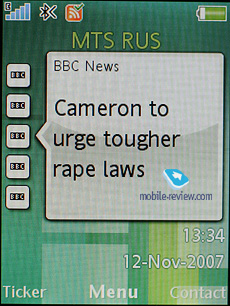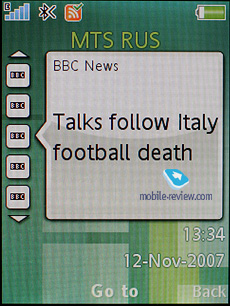|
|
Review of GSM/UMTS-handset Sony Ericsson K660i
Table of contents:
- Positioning
- Design, size, controls
- Display
- Keypad
- Battery
- Memory, memory cards
- Connectivity
- Performance
- Camera
- Preinstalled applications, themes, games
- Music department
- RSS Ė revamped client
- WEB-browser
- Competition
- Impressions
Sales package:
- Handset
- Battery (BST-33, 950 mAh Li-Pol)
- M2 memory card (256 Mb)
- USB data cable (DCU-60)
- Charger
- Wired stereo-headset (HPM-52, 3,5mm jack)
- User Guide
Positioning
With a standard platform implemented across its range, any company has to figure out a trick or two to set its offerings apart, putting them into different niches on the market, so they will look different to consumers. Until recently Sony Ericsson didnít have this issue at hand at all Ė all of its product would turn out to be totally different and shrewdly segmented. However, the recent inflation of its portfolio has brought about a change in the company strategy as well Ė that is, whereas previously platforms A100 and A200 came fully kitted-out with core functionality and preinstalled applications that didnít change throughout the range, in 2008 we will see a somewhat different approach. Every new device Sony Ericsson will roll out will be coming in with a special touch, which all will be stitched together in the next version of the platform. Nevertheless, this strategy is by no means new Ė it is already being exercised by Nokia with its S60 solutions and has proven to be sustainable.
For the Sony Ericsson K660iís positioning, it is clearly a youth-aimed device Ė speaking in favor of this guess are its flashy and off-the-wall color options, and web browsing coming in as one of its major abilities. The K-series has never seen models with a knack for something particular Ė they packed the same suite of features like all other devices, could be different design- and camera-wise or sport some extra goodies under the hood, but thatís about it. However these days, specialization is all around, making its way to specific models, like the Sony Ericsson K530i, which is a cheap navigation-savvy phone coupled with the HGE-100 GPS-enabler, at least thatís the way it was originally devised. A part of the K-series is known as the Cyber Shot range, meaning that these solutions are all imaging-heavy offerings. This way, this very range becomes quite tricky positioning-wise, since the K index no longer signifies some particular focus. Thus the company looks right down at the necessity to expand its index pool, or revise the way some of its offerings are positioned.
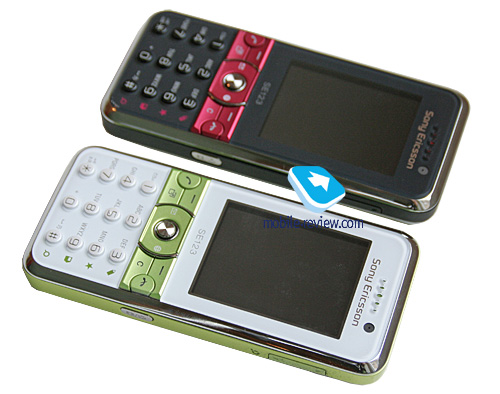
Had the T index maintained its place for the mid and high price-brackets of the companyís range, then all solutions akin to the Sony Ericsson K660i would have fitted this index nicely. Whether the company will be developing whole branches of its solutions, like its imaging-, music- and pretty soon gaming-savvy devices is yet to be revealed. In other words, the K660i could well launch a line-up of browsing-heavy offerings, but this doesnít seem to be really possible Ė it would look way too farfetched as a centerpiece.
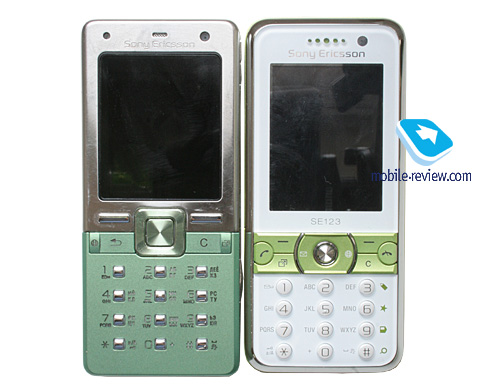
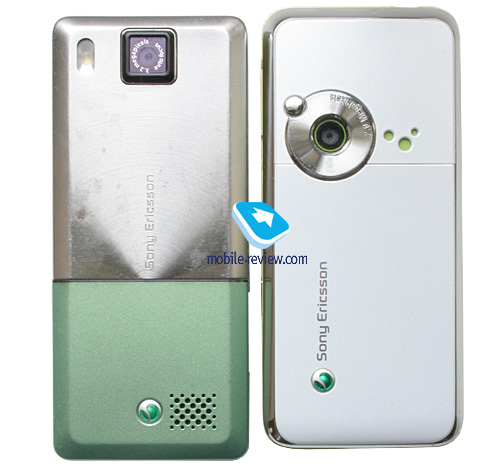
Generally speaking, Sony Ericssonís segmentation of handsets, as its portfolio keeps growing, is starting to look pretty much messy. Coming from way back are its letter indexes, and the companyís latest addition to models in all line-ups Ė ďemotionalĒ design. The manufacturerís primary goal is to sell a phone, and ďemotionsĒ that consumers will experience are only one of the constituents here, other aspects, like functionality, also matter.
So happens that the K6xx handsets are 3G-enabled solutions, always craved by operators in one way or another. And the maker couldnít be happier, since he doesnít necessarily need to roll out something extraordinary within this line-up Ė a robust device will always do. But thatís the place where Sony Ericssonís policy goes wrong. As far as high-volume carriersí orders are concerned, these phone turn out to be relatively cheap, and carriersí bargain prices do the rest Ė the user gets a pretty potent handset for very little money on a contract he always owns. In other words, these solutions come to replace old contracted phones, boosting them from 2.5G to 3G at that.
But whatís the companyís line on free markets? They hang the heftiest price tags on these phones, and generally give up outstanding sales in favor of the image of an expensive brand and increase of the demand for carrier-branded phones. At some point in time this approach was the right thing to do, for carriers play one of the key roles in Sony Ericssonís development strategy. However, there are to sides to the coin. The less shiny facet brought about very modest sales of such offerings, for instance the Sony Ericsson K600i sold in smaller quantities than it should have. And this was the real reason why the company dropped this modelís price in such a dramatic fashion Ė over a small period of time, they knocked it all the way down from 450 USD to 250-260 USD, where it started selling pretty well, yet totally compromised other goals of the maker (image making, for example). The Sony Ericsson K610iís fate wasnít much different, even though its price curve was smoother, as they moved down the pricing ladder with the experience of the K600i in mind.
Another model that will be positioned exactly in the same vein is the Sony Ericsson K660i (while we are leaving the K630i out for now, we will get back to it a tad later in this review). By and large, the new handset has adopted a bevy of flashy trims, yet swayed more towards the youth, which is also thanks to its predecessors that were popular with younger consumers. But as I see it, the company has confused cause for effect in this case Ė their market specialists, for some obscure reasons, thought the K6xx line-upís popularity stemmed from spec sheets, even though the real popularity boosters were their price curve or availability of carrier-branded editions, plus flamboyant color options.
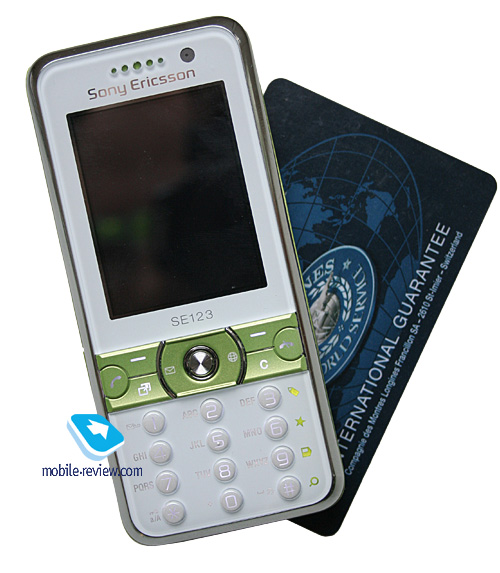
It matters not what the designers of the Sony Ericsson K660i (code-named Chen) had on their minds, though. They have come up with a youth-aimed model in the sense of both style and positioning. Letís put it that way Ė the K660i has one target audience, comprising young people between 20 and 30 years old, not very tech-savvy, as far as mobile phones are concerned, so they are definitively not Techi, although the latter may well find the K660i appealing (for its design alone). So, generally, this handsetís idea is to offer the youth a solution for web surfing.
Secondary target groups include older consumers, but they wonít generate as much sales as the youth, for they will be put off by the K660iís snazzy colors and web browsing-inclined positioning, which is usually deemed superfluous by these people.
Back to the table of contents >>>
Design, size, controls
We were quite surprised to find this model being so flamboyant and festive Ė you will guess the K660iís target audience by the way it looks instantly. Its color schemes havenít been applied in other products as yet, so the handset looks pretty quirky in general. Just like any snazzy and off-the-wall solution the Sony Ericsson K660i can be either loved or hated Ė nobody comes out indifferent to its design.
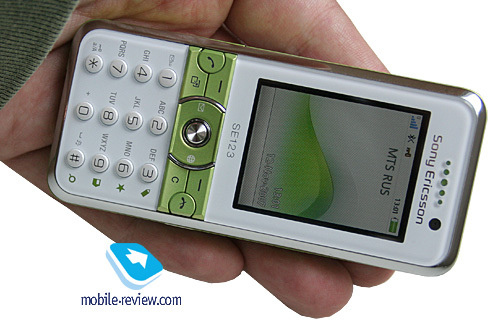

The phone comes in a choice of two colors Ė Lime on White and Wine on Black. Both trims share the glossy plastic of the front fascia, which is, obviously, prone to fingerprints. While the rear of white edition of the K660i doesnít suffer from the same shortcoming, all thanks to its matte white finish, the black color option of the K660i has both its face and rear decked out in glossy grease-magnet plastic.
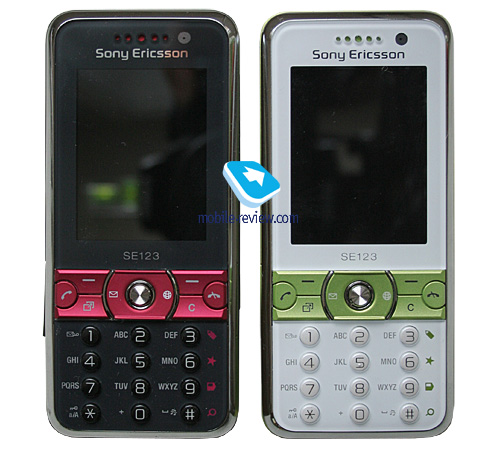



Surprisingly enough, two color solutions of one and the same model significantly differ in terms of the materials used. The spines of the black variant of the K660i are kitted out in soft plastic, somewhat reminiscent of the ďsoft-touchĒ finish, making for a very good tactile feel and non-slippery casing. And on the other hand, the white edition of the handset has its sides clad in no-frills neon-lime plastic.
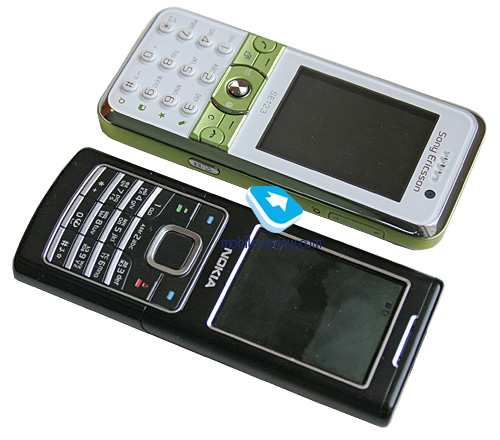
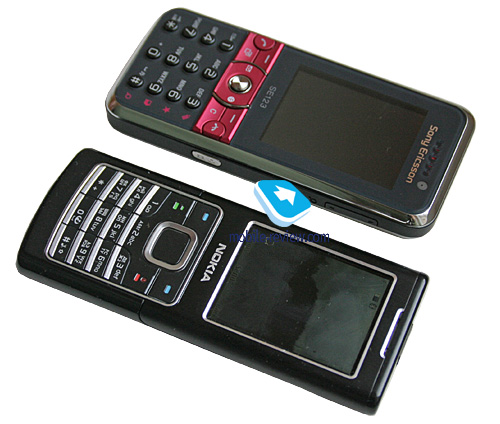
We can hardly find a thing to fault the K660iís plastic on Ė after a month of quality time, which was pretty rough for the phone on top of that, we didnít seem to have done significant damage to the K660i. Among the letdowns is the lens framing on the rear, which adds a cool touch to the handsetís looks thanks to its circular pattern. Even if go ahead and scratch these circles with your nails, you wonít feel that the surface is embossed or something. But put the K660i into your jeans pocket for a while and take it out to find this rim scratched and scuffed.
In terms of design they have tried to style this phone after the Sony Ericsson K810i Ė and actually they do seem somewhat resembling, specifically with their similar keypads and overall looks.
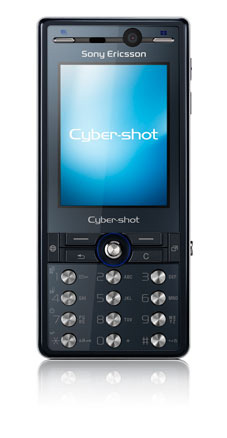

The K660i houses two edgings on the opposite ends of the phone, which appear to be metallic, but in fact they are nothing but chromed plastic. The K660i doesnít have metal parts anywhere else either. The handset feel robust, we have no gripes with its build quality, and the only part we can complain about is the battery compartment cover, designed in the way that it can be opened very easily, even if you do it accidentally. And should you happen to drop the phone, the back cover will always fly apart from it, which isnít a bad thing after all.
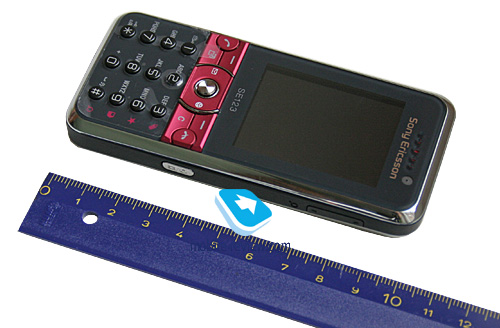
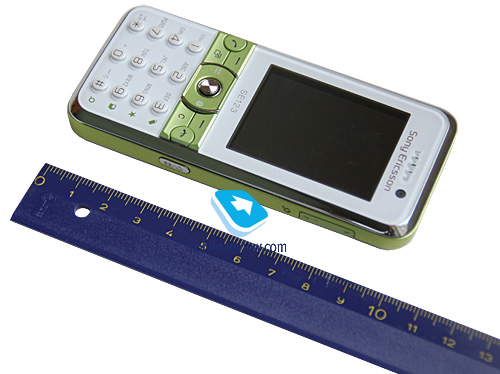
The K660i tips our scales at 95 grams, and it doesnít feel like a lightweight while in the hand. Measuring up at 104x47x15mm it is a very run-of-the-mill candy-bar shaped handset, thatís why you will never find yourself pondering over how and, more importantly, where to put it.


The top end hosts the power button, while at the bottom you will find the microphone grill, as well as the lanyard eyelet and the Fast Port socket. Sitting on the left side is the M2 memory expansion slot covered by a plastic flap linked up to the casing. On the right are the volume rocker and a dedicated camera key.
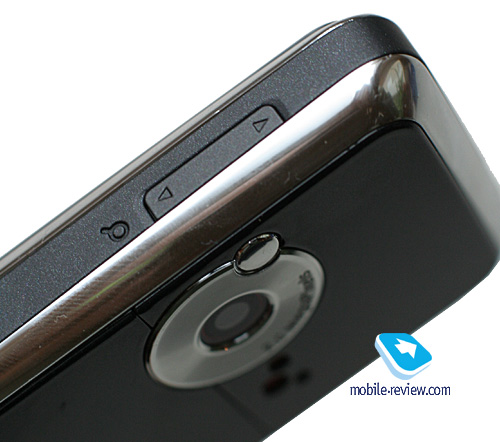
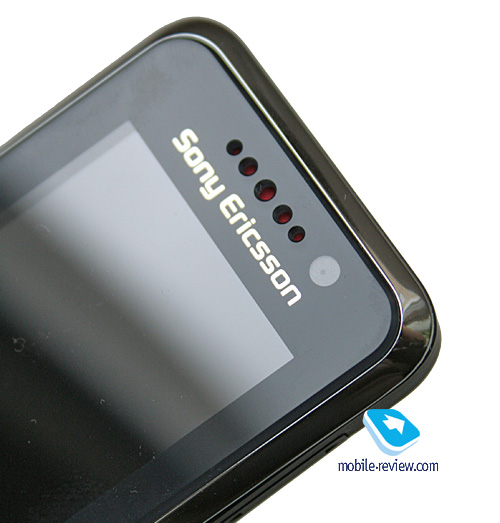

Flipping over to the K660iís underside you will find the 2 Mpix camera lens and the loudspeaker hole. Topping the display on the front fascia is a forward-facing camera for videoconferencing.
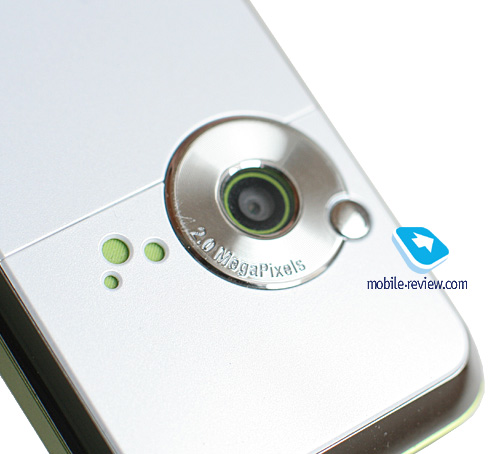
Back to the table of contents >>>
Display
The handsetís display shows up to 262 K colors in the resolution of 240x320 pixels (2-inch diagonal, TFT, 30x40mm) Ė this allows accommodating up to 8 text and 3 service lines in most modes. For web- and mail-browsing you can have more text lines on the screen by decreasing the font size. While the K660iís display does well under direct sunlight, its diagonal is on the small side, so you will often need to take a good look at it to actually read information.
Comparing the K660i with the current generation of phones, it appears that either the display supplier has changed or they have altered the display type. Basically, the phoneís screen is much brighter and crisper now, even though it was already pretty vibrant, like on the Sony Ericsson W580i, packing one of the marketís best displays. So the our only niggle, many view as crucial, though, is the K660iís tiny diagonal, which, in fact, seems to be somewhat out of place on a web-browsing savvy phone, it would have been better off having a 2,4-inch display or better onboard.
Back to the table of contents >>>
Keypad
The navigation cluster is painted in a different color than the rest of the keypad and thus is easy to spot. There is no joystick on the K660i Ė it is replaced by a four-way navi-key with the OK button sitting inside, and this particular design actually does look similar to a joystick. The handsetís D-pad is exactly the same as that found on the Sony Ericsson W890i, where I liked it and found it a treat to manage. Regrettably, the Sony Ericsson K660i doesnít come close to this level of comfort with its pretty much average ergonomics, though it is not that bad. Basically, with so much leftover space, they could easily make this control bigger.
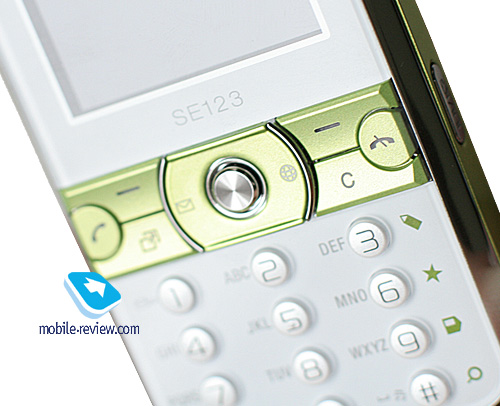
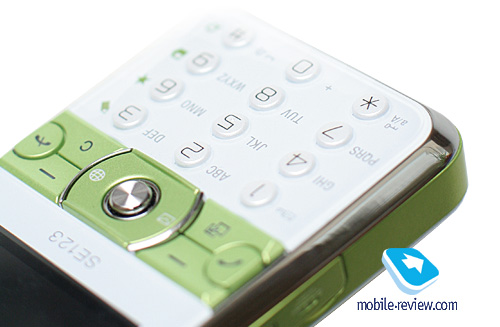
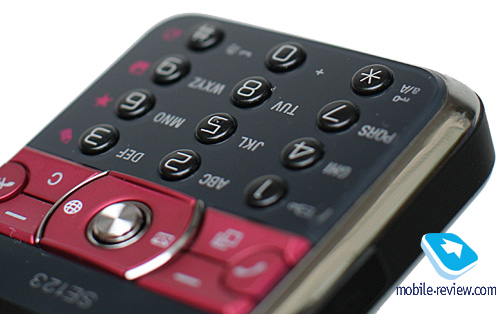
The rounded numeric buttons are smallish in size and quite average usability-wise, however you will come to grips with them in no time. Interestingly, the numbers themselves are engraved on the keys, whereas the alphabet is written in between the buttons. On the right sits the browser-related icon bar, but weíll get to it later. In essence, the approach employed by the K660i has been adopted from the Sony Ericsson K810i, which had special icons for its camera mode.
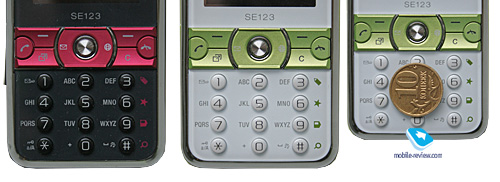
All keys are lit in white, no ambient light sensor ships with the K660i.
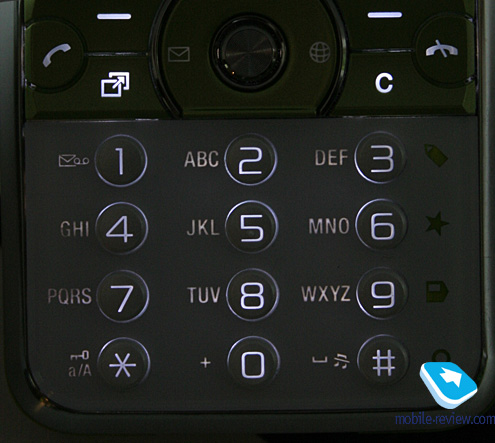
Back to the table of contents >>>
Battery
The handset employs a 950 mAh Li-Pol battery (BST-33), and according to the manufacturer it is good for up to 9 hours of talk time and 330 hours of standby.

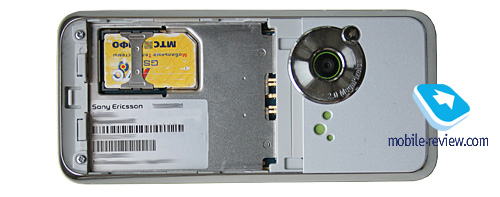
In Moscow we managed to squeeze around 2,5-3 days out of it with average use (up to an hour of calls, 30 minutes of games, 20 minutes of web-browsing, a couple of hours of music). In Europe its battery performance will get at least 1,5 times better all thanks to superior coverage. We got around 14.5 hours of music out of the K660i. It takes the handset around 2 hours to charge up.
Back to the table of contents >>>
Memory, memory cards
The handset boasts around 32 Mb of user-manageable memory, also its sales package includes an M2 memory card (256 Mb, the K660i supports up to 4Gb, and more capacious cards, when they arrive, will do as well) Ė you can also swap these cards on the go.
Back to the table of contents >>>
Connectivity
USB
On USB-connection you are forced to pick connection type Ė specifically whether you will be accessing data stored on the memory card to just keep managing the phone or activate Print mode. Also there is Media Transfer (MTP mode for accessing, say, Windows Media Player). For the first mode we mentioned above the handset goes off and you gain access to the contents of both the memory card and the phoneís internal memory. Despite the maker claiming it to be USB 2.0, data transfer speed doesnít exceed 500 Kb/s. If you just want your K660i to turn into a modem, then pick the second option, when you will have a chance to play around with various USB settings for going online.
Bluetooth
The handset comes with EDR-enabled Bluetooth 2.0, the menu enables you to turn on enhanced power saving mode. There is also A2DP support, which allows employing wireless headsets with the K660i. Its data transfer speed tops out at 100 Kb/s. The list of supported profiles:
- A2DP
- Basic Imaging Profile
- Basic Printing Profile
- Dial-Up Networking Profile
- File Transfer Profile
- Generic Access Profile
- Generic Object Exchange Profile
- Handsfree Profile
- Headset Profile
- HID
- JSR-82 Java API
- Object Push Profile
- Personal Area Network Profile
- Serial Port Profile
- Service Discovery Application Profile
- Synchronization Profile
- SyncML OBEX binding
The handset also supports HSDPA connectivity.
Back to the table of contents >>>
Performance
The K660i puts up typical numbers for the companyís latest generation of devices and is ahead of most models available on the market. There are no limits on JAR-file size, HEAP size Ė from 512 Kb to 1.5 Mb.
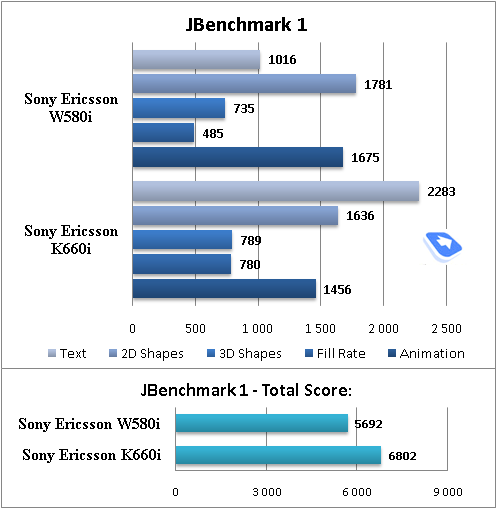
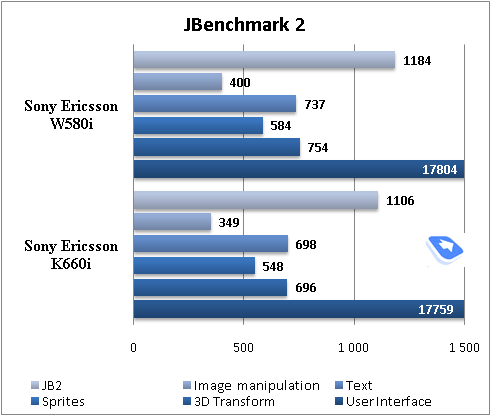
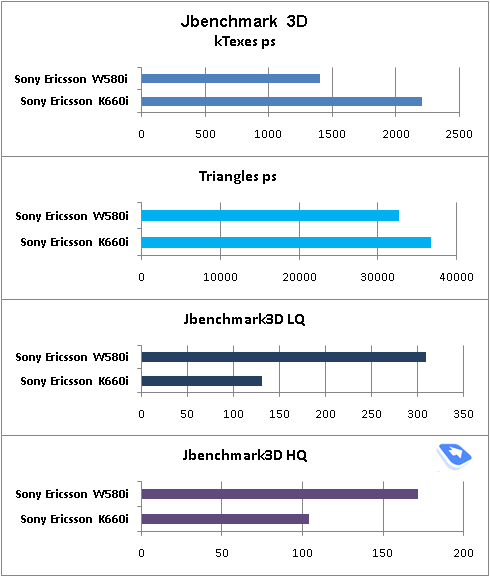
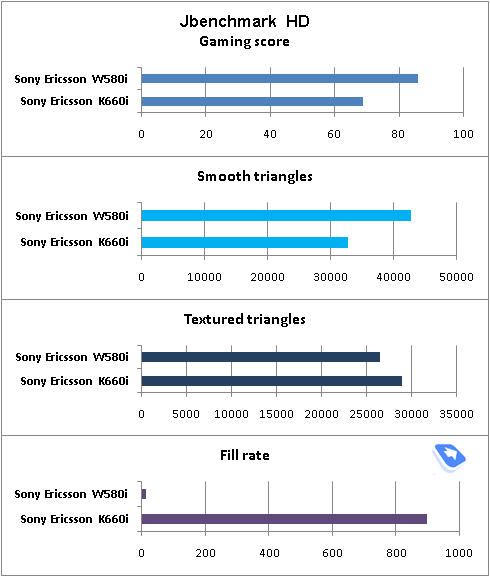
Back to the table of contents >>>
Camera
The device is equipped with a 2 MP camera with a CMOS matrix without auto-focus. The device supports three possible resolutions - 1632x1224, 640x480, 160x120. Two types of data compression (Normal and Fine) are at your disposal. The majority of the sample photos are in the Fine quality. A photo in the Normal mode takes up about 300 KB while the Fine quality results in 500-600 KB. Saving a photo takes the same time not depending on chosen type and makes about 1-2 seconds, and that is quite speedy for such file size.
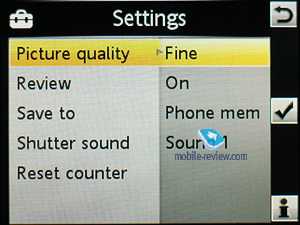

The model employs the new Cyber-Shot interface, which is indicated by its dedicated Settings menu. You can also enable auto image rotation (all thanks to the motion sensor). While the cameraís menu looks different, these changes havenít affected its performance.
The camera settings look in the following way:
- Shutter sound. You can choose one of the three shutter sounds, but will not be able to turn the sound off.
- White balance. A possibility to choose between an auto-mode, Incandescent, Fluorescent, Daylight.
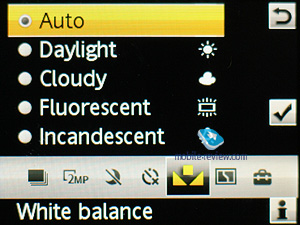
- Effects. Several effects may be applied to the photos. These are Negative, Solarize, Sepia, Black & White.
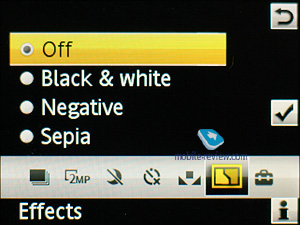
- Timer is activated for a certain time period for self shooting.
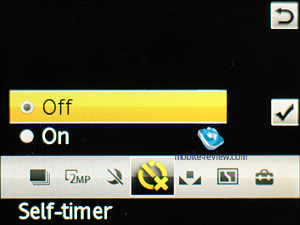
- Night mode is for shooting in the dark. Noises raise on a photo, exposure time gets increased (you shouldn't move the device in order not to get a blurry photo).
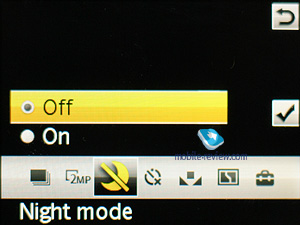
- Shooting mode. Normal mode that takes ordinary photos. Multishot-mode (Burst 4) allows taking four photos in a series. Landscape is a very interesting mode that allows taking rather fetching photos; the market hasnít seen anything similar to date yet. The last mode is taking photos with frames, the image resolution is reduced automatically.
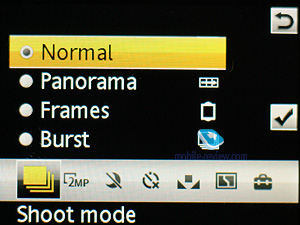
The screen serves as a viewfinder while in the shooting mode. The picture moves very smoothly, details donít get dropped out. Numeric keys help in switching between various functions and shooting parameters quickly that significantly speeds up the cameraís operation.
 |
 |
| (+) maximize, 1600x1200, JPEG |
(+) maximize, 1600x1200, JPEG |
 |
 |
| (+) maximize, 1600x1200, JPEG |
(+) maximize, 1600x1200, JPEG |
 |
 |
| (+) maximize, 1600x1200, JPEG |
(+) maximize, 1600x1200, JPEG |
 |
 |
| (+) maximize, 1600x1200, JPEG |
(+) maximize, 1600x1200, JPEG |
 |
 |
| (+) maximize, 1600x1200, JPEG |
(+) maximize, 1600x1200, JPEG |
 |
 |
| (+) maximize, 1600x1200, JPEG |
(+) maximize, 1600x1200, JPEG |
 |
 |
| (+) maximize, 1600x1200, JPEG |
(+) maximize, 1600x1200, JPEG |
 |
 |
| (+) maximize, 1600x1200, JPEG |
(+) maximize, 1600x1200, JPEG |
 |
 |
| (+) maximize, 1600x1200, JPEG |
(+) maximize, 1600x1200, JPEG |
 |
 |
| (+) maximize, 1600x1200, JPEG |
(+) maximize, 1600x1200, JPEG |
 |
 |
| (+) maximize, 1600x1200, JPEG |
(+) maximize, 1600x1200, JPEG |
Video
Video may be recorded in two resolutions (176x144, 128x96). File format is 3GP. Clip duration may be limited (up to 10 seconds) or unlimited. The quality of the clips is beneath any criticism; so far this has been the weakest spot of all Sony Ericsson-branded devices.
Back to the table of contents >>>
Preinstalled applications, themes, games
We wonít review the K660iís standard feature pack, for it comprises all the goodies of the A200, which were given an in-depth close-up in a dedicated article. So here we will be focusing on the phoneís unique abilities and features.
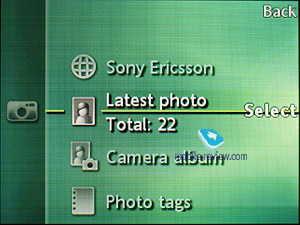




The phone comes preinstalled with 5 different themes, all of them involving flash animation to some extent.
The K660i has three games in stock: JS Does Texas, QuadraPop, RollerCaster Rush 3D






The Applications section houses FaceWarp and AccuWeather.
Back to the table of contents >>>
Music department
Despite the fact that the K660i isnít one of the Walkman breed, it delivers pretty good sound quality, which is nothing to be shocked about Ė its sound is processed exactly in the same manner. While we found this handset worthy sound-wise, it was still far behind other music-heavy phones from Samsung, Nokia, Motorola.
One of the letdowns to the K660i is missing headset in the sales package, even more so for its target audience. However, over at Sony Ericsson they didnít want to dilute the phoneís focus, so they limited it this way, which is, generally, the right thing to do.
The handset ships with MegaBass, multimedia menu and other makings of a typical A200-powered device Ė we are not going any deeper than that, however, as all specs were covered in our dedicated write-up. So all we have left to do here is add that the K660i also comes bundled with FM-radio and quote what Alexander Dembovsky had to say about this handsetís audio performance.
RightMark Audio Analyzer test:
General performance
Frequency response (from 40 Hz to 15 kHz), dB: |
+0.11, -0.72 |
Good |
Noise level, dB (A): |
-71.4 |
Average |
Dynamic range, dB (A): |
71.4 |
Average |
THD, %: |
0.0082 |
Very good |
IMD, %: |
0.082 |
Good |
Stereo crosstalk, dB: |
-71.4 |
Good |
Intermodulation at 10 kHz, %: |
0.088 |
Good |
General performance: Good
Frequency response

Noise level

Alexander Dembovskyís take on the K660i:
As you can learn from its Rightmark Audio Analyzer performance, the K660i fares well, although its output signal strength is pretty sub-par, so you will have to find a proper pair of earphones, probably earbuds.
As far as the K660iís sound is concerned, it is pretty smooth, except for a roll-off in deep basses. Those who like when bass is blasting into their ears will need to elevate the lows manually. As for the rest, the K660i is pretty much in keeping with the companyís latest and greatest offerings.
RSS Ė revamped client
Compared with the default version of A200, the RSS-reader found in the K660iís Messaging menu has changed somewhat. The settings now allow you to bring RSS headers to the standby screen, when the display features a vertically arranged icon bar and headers on the right. If you unlock the keypad, you will be able to navigate this bar and pick particular news items. And just like before, you are free to tap into any RSS channels you want, update them manually or have them refreshed on schedule.
The K660i also comes included with the Podcasts section with settings for content upload (what content types will be downloaded onto the handset, whether it will be uploaded only upon a PC connection). Functionality-wise, this RSS-client is somewhat reminiscent of Motorolaís SCREEN3 technology.
Back to the table of contents >>>
WEB-browser
Much like those imaging-minded buttons found on the Sony Ericsson K810i, the K660i sports an array of keys for managing the browser. You can launch this application by pressing the navi-key right, and then the display will toggle to the landscape mode automatically.
The major thing setting the K660iís browser apart from the default NetFront application incorporated into the A200 is the thumbnail mode, much like that found in Opera Mini and the S60 browser. In a word, it makes surfing large pages so much easier. Other changes include the pointer which serves for navigating through web-pages and selecting certain page elements. However all these improvements donít make all the difference, but rather slightly boost the browserís functionality overall







Whatís disappointing about the K660iís browser is that while you browse pages in the album mode, you will have to input all data and info in the portrait mode. In terms of ergonomics, this is not a consistent approach. But if you look at the keypad, which is also laid out vertically, you will probably get it. However, subconsciously you really want the display not to toggle back to the portrait mode. And this is all another proof that the lack of a touch-sensitive display always implies a compromise, leading to overcomplicated interactions with the phone that could have been avoided otherwise.
What do we like about the browser? Shortcuts on the keypad. And other aspects, by and large, are not very different from the default A200 browser. Browser-wise, the K660i doesnít have any substantial edge over other models, being rather an attempt to bring about a new way of device positioning.
Back to the table of contents >>>
Competition
Back in the Positioning part of the write-up we told you we were getting back to the Sony Ericsson K630i, so now is the time to do that. This is third or fourth, depends on how you look at it, device in the K6xx line-up. However, it turns out to be almost an exact replica of the model reviewed today, except for the browser and RSS enhancements. It starts shipping in December 2007 for around 400-450 (being on a par with the K660i) with the same sales package, but what really differs is the way it is positioned Ė the K630i is dubbed as a music-savvy solution. No frills design, focus on music (even though it is not in the Walkman range) and business. As I see it, this example clearly demonstrates how farfetched current Sony Ericssonís phone positioning is. The company obviously needs to revise the way it segments its solutions Ė they just need to make it clear and transparent for consumers.
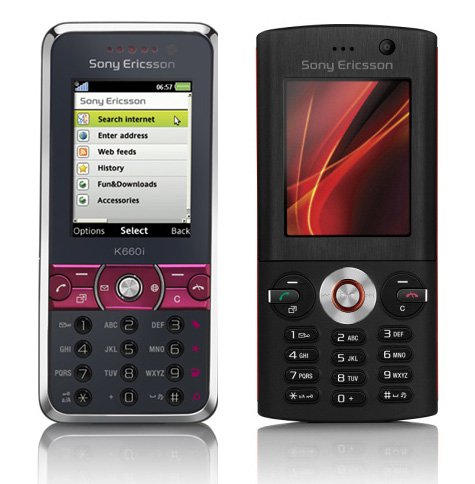
There is a whole array of rivals to the K660i on the market, and I donít think that looking into each of them is a particularly good idea. Thatís why we will go over only those targeting the same audience. Among these is the Nokia 6120 Classic, which differs from the K660i by being an S60 smartphone, packing all generic features of this platform. Their dimensions are pretty much comparable, although the latterís battery life is shorter, which comes as no surprise. Given the 6120 Classicís 400 USD price tag, this is one decent offering Ė thankfully, it shows off a comparable display diagonal and more feature-rich browser and mail client.
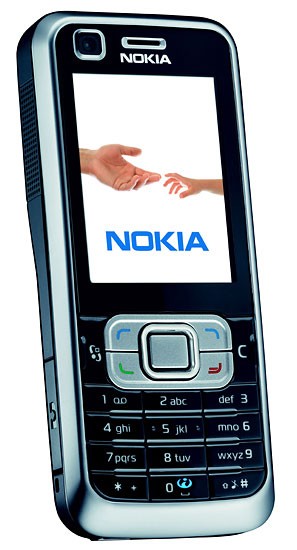
Also rivaling the K660i is the Nokia 6233 if only it manages to maintain its presence on the shelves of retail stores early in 2008, which is very unlikely.
The handsetís high initial price (for free markets like Russia) drives it in a wholly different division functionality-wise. For instance, the Motorola E8 will have almost equally hefty price tag, yet will come with more memory onboard and a couple of fundamental differences and improvements. Price is the main limitation of the Sony Ericsson K660i, as all features positioned as centerpieces, in fact donít qualify as such. Take the Sony Ericsson K800i with its almost identical ergonomics of web applications to see that the K660iís amenities canít cost that much after all.
Back to the table of contents >>>
Impressions
While the handsetís overall volume level is average, its sound is on the juicy side. You will also have no trouble hearing ring tones while in the street. The vibro alert is average or a little bit above this level strength-wise, but occasionally you might not feel it. The reception part is in line with other products from the company, meaning that it is quite decent.
The phone starts shipping in February 2008 for 400-500 USD (in Europe Ė 260-280 Euro). For this money consumers will get a quirky design, all standard features of the A200 and a handful of tiny extras. This is not the most decent offering price/quality ratio-wise we have seen, but it does make a statement with its design. I suppose the Sony Ericsson K660iís design will be its foremost selling point. If you fall for it, then getting your mitts on it will be a matter of principle. In a word, emotional and impulse-driven purchases as they are. This way, the model wonít be vastly popular on the market, but all previous K6xx solutions werenít either.
Related links:
Back to the table of contents >>>
Eldar Murtazin (eldar@mobile-review.com)
Translated by Oleg Kononosov (oleg.kononosov@mobile-review.com)
Published — 22 October 2007
Have something to add?! Write us... eldar@mobile-review.com
|
News:
[ 31-07 16:21 ]Sir Jony Ive: Apple Isn't In It For The Money
[ 31-07 13:34 ]Video: Nokia Designer Interviews
[ 31-07 13:10 ]RIM To Layoff 3,000 More Employees
[ 30-07 20:59 ]Video: iPhone 5 Housing Shown Off
[ 30-07 19:12 ]Android Fortunes Decline In U.S.
[ 25-07 16:18 ]Why Apple Is Suing Samsung?
[ 25-07 15:53 ]A Few Choice Quotes About Apple ... By Samsung
[ 23-07 20:25 ]Russian iOS Hacker Calls It A Day
[ 23-07 17:40 ]Video: It's Still Not Out, But Galaxy Note 10.1 Gets An Ad
[ 19-07 19:10 ]Another Loss For Nokia: $1 Billion Down In Q2
[ 19-07 17:22 ]British Judge Orders Apple To Run Ads Saying Samsung Did Not Copy Them
[ 19-07 16:57 ]iPhone 5 To Feature Nano-SIM Cards
[ 18-07 14:20 ]What The iPad Could Have Looked Like ...
[ 18-07 13:25 ]App Store Hack Is Still Going Strong Despite Apple's Best Efforts
[ 13-07 12:34 ]Infographic: The (Hypothetical) Sale Of RIM
[ 13-07 11:10 ]Video: iPhone Hacker Makes In-App Purchases Free
[ 12-07 19:50 ]iPhone 5 Images Leak Again
[ 12-07 17:51 ]Android Takes 50%+ Of U.S. And Europe
[ 11-07 16:02 ]Apple Involved In 60% Of Patent Suits
[ 11-07 13:14 ]Video: Kindle Fire Gets A Jelly Bean
Subscribe
|































































